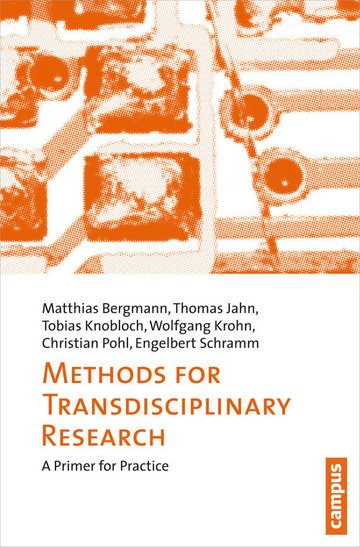| Contents | 6 |
| Preface to the English edition | 10 |
| Foreword to the English edition | 12 |
| Introduction to the 2010 German edition | 14 |
| Structure of the book and how to use it | 18 |
| How to use the method collection and examples | 20 |
| Chapter I: The integrative approach in transdisciplinary research | 23 |
| Chapter II: Integration methods—An overview of individua lmethods for transdisciplinary research practice | 51 |
| II.A Integration through conceptual clarification and theoretical framing | 54 |
| A.1 Integration through interdisciplinary conceptual work | 58 |
| A.2 Integration through theoretical framing | 66 |
| II.B Integration through research questions and hypothesis formulation | 74 |
| B.1 Integration through joint formulation of relevant research questions | 75 |
| B.2 Integration through the formulation of hypotheses | 77 |
| II.C Screening, using, refining, and further developing effective integrative scientific methods | 80 |
| C.1 Integration through screening existing (inter)disciplinary methods and identifying methodical needs | 81 |
| C.2 Integration through interdisciplinary development of methods | 83 |
| C.3 Integration through adopting established transdisciplinary methods | 86 |
| II.D Integrative assessment procedures | 90 |
| II.E Integration through the development and application of models | 96 |
| II.F Integration through artifacts, services and products as boundary objects | 106 |
| F.1 Integration through artifacts, services and products | 107 |
| F.2 Integration through publications | 113 |
| II.G Integrative procedures and instruments of research organization | 116 |
| G.1 Integration through the formation of interdisciplinary teams | 116 |
| G.2 Integration through stakeholder involvement and participation | 125 |
| G.3 Integration through iteration/recursiveness | 130 |
| G.4 Integration through key question procedure at end of project | 133 |
| Chapter III: Integration strategies—Examples of comprehensive concepts in research practice | 137 |
| III.A Preliminary remark | 137 |
| III.B Example 1: Strategies for a sustainable urbanmobility—Integration through interdisciplinary method development | 138 |
| B.1 Framework conditions and project’s research goal24 | 138 |
| B.2 Research strategy and integration methods | 140 |
| B.3 Project brief | 151 |
| III.C Example 2: Demography and supply systems—Integration through theoretical work and model development | 153 |
| C.1 Framework conditions and project’s research goal | 153 |
| C.2 Research strategy and integration methods | 155 |
| C.3 Project brief | 170 |
| III.D Example 2: Decline of fish populations—Integration through formulation of hypotheses with stakeholder participation | 173 |
| D.1 Framework conditions and project’s research goal | 173 |
| D.2 Research strategy and integration methods | 174 |
| D.3 Project brief | 182 |
| III.E Example 4: A reconception of grazingland management—Integration through inclusion of everyday action | 184 |
| E.1 Framework conditions and project’s research goal | 184 |
| E.2 Research strategy and integration methods | 185 |
| E.3 Project brief | 191 |
| III.F Example 5: Adapted health services for nomadic pastoralists—Integration through the inclusion of at arget group | 193 |
| F.1 Framework conditions and project’s research goal | 193 |
| F.2 Research strategy and integration methods | 194 |
| F.3 Project brief | 200 |
| III.G Example 6: Sustainable housing renovation—Integration through including practice partners and through product orientation | 203 |
| G.1 Framework conditions and project’s research goal | 203 |
| G.2 Research strategy and integration methods | 204 |
| G.3 Project brief | 210 |
| III.H Example 7: Sustainability and urban design—Integration through cross-disciplinary categorial systems and iterative forms of work | 212 |
| H.1 Framework conditions and project’s research goal | 212 |
| H.2 Research strategy and integration methods | 214 |
| H.3 Project brief | 220 |
| III.I Example 8: Water demand forecast for Hamburg—Integration through continual design of the research process and operationalization of the product | 221 |
| I.1 Framework conditions and project’s research goal | 221 |
| I.2 Research strategy and integration methods | 223 |
| I.3 Project brief | 229 |
| III.J Example 9: Situated human-machine communication—Integration through the development of an artifact | 230 |
| J.1 Framework conditions and project’s research goal | 230 |
| J.2 Research strategy and integration methods | 233 |
| J.3 Project brief | 243 |
| III.K Example 10: Nature conservation and agricultural production—Integration through the elaboration of guiding principles | 246 |
| K.1 Framework conditions and project’s research goal | 246 |
| K.2 Research strategy and integration methods | 247 |
| K.3 Project brief | 252 |
| III.L Example 11: Evaluation of transdisciplinary research—Integration through joint learning in an iterative process | 254 |
| L.1 Framework conditions and project’s research goal | 254 |
| L.2 Research strategy and integration methods | 255 |
| L.3 Project brief | 261 |
| Chapter IV: Integration supportive aspects of the management of transdisciplinary research processes and groups | 263 |
| IV.A Management strategies for an integrated project process | 264 |
| IV.B Integration planning, problem description, research questions and research objectives | 267 |
| IV.C Coordination, communication and learning processes | 270 |
| IV.D Quality management, criteria and products | 275 |
| Chapter V: Further instructions for use | 277 |
| V.A Project phase reference of the integration methods and instruments | 278 |
| V.B Functional order of integration methods | 279 |
| V.C Classification of integration strategies of the projects according to integration types | 282 |
| V.D Overview of integration methods and integration strategies | 283 |
| Chapter VI: References | 287 |
| About the authors | 291 |
| Index | 293 |















